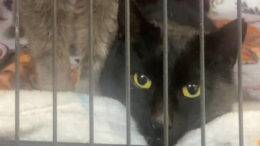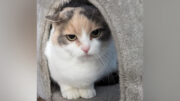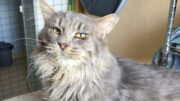This week’s weather brought several visitors to the bird feeders. Most noticeable of these included many pine siskins. They dominated the thistle feeder pretty much the entire weekend.
A quick check of the entry for pine siskins on the Cornell Lab of Ornithology’s All About Birds website, produced a chuckle from this blogger. The chortle-producing excerpt read “flocks of tiny pine siskins may monopolize your thistle feeder one winter and be absent the next.”
Never were truer words spoken – or posted online.
The All About Birds entry for the little finches – siskins are finches – said the birds “range widely and erratically across the continent each winter in response to seed crops.”
They are described as travelers and talkers.
“They are gregarious, foraging in tight flocks and twittering incessantly to each other, even during their undulating flight,” All About Birds said.
This was quite evident in the exciting squabbling at the feeder.
The site said that every couple of years the siskins make “unpredictable movements called irruptions into southern and eastern North America.”
Some interesting facts included that the siskins can make it through the cold winter nights by ramping up their metabolic rates.
All about birds said the siskins can temporarily store seeds totaling as much as 10 percent of their body mass in a part of their esophagus called the crop.
This may be some of the reason behind the thistle feeder drain.
Other visitors
Meanwhile, black-capped chickadees, tufted titmice, white-breasted nuthatches, dark-eyed juncos and an American tree sparrow all made appearances at the feeders.
Fears that this year there was a decline in chickadees were quickly eased as at least 10 of the small birds were observed over the weekend.
The All About Birds description is again right-on-the-money stating, “a bird almost universally considered ‘cute’ thanks to its oversized round head, tiny body, and curiosity about everything, including humans.”
One cool fact about chickadees is that they seemingly serve as an early warning alarm system for other birds.
“Most birds that associate with chickadee flocks respond to chickadee alarm calls, even when their own species doesn’t have a similar alarm call,” All About Birds said.
And apparently, chickadees have adapted a system to avoid crowding at the feeder.
A post on www.audubon.org titled “How chickadee flocks avoid traffic jams at your feeder,” provides some insight.
The post, which was originally a podcast, said that most chickadees wait their turn at the feeder.
“When a whole flock of chickadees moves into your yard, it looks as if they form a living conveyor belt. One chickadee after another, flies to the feeder and then leaves with a seed,” the post said.
Don’t always blame the chipmunks
It is also turns out that chickadees are hoarders and, after scouting the internet, it turns out that several winter birds are hoarders.
All About Birds said the chickadee hides food and “each item is placed in a different spot and the chickadee can remember thousands of hiding places.”
Other hoarders include tufted titmice and white-breasted nuthatches.
“If you see a white-breasted nuthatch making lots of quick trips to and from your feeder – too many for it to be eating them all – it may be storing the seeds for later in the winter, by wedging them into furrows in the bark of nearby trees,” All About Birds listed on its bird identification sight.
The site said that tufted titmice only take one seed per trip and usually shell the seeds before hiding them.
Mean while, several dark-eyed juncos continue to visit the feeders or rather clean up underneath them.
“Dark-eyed juncos are birds of the ground. They hop around the bases of trees and shrubs in forests or venture out onto lawns looking for fallen seeds,” All About Birds said.
The site also said the junco is one of the most common birds in North America and it set a recent estimate of the bird’s number at approximately 630 million individuals.
Also spotted was an American tree sparrow who was trying to vie for a place at the thistle feeder. The region is included in the tree sparrow’s winter range.
Additional info
Internet searching also turned up some interesting tidbits.
A article titled “Coming for Winter 2017-18: A Crush of Crossbills,” by Marc Devokaitis, also posted on All About Birds, said that folks might want to keep a look out for red crossbills.
“Thanks in part to the drought of 2016 and wet spring of 2017, this winter the spruces, hemlocks, pines, and other conifer trees across parts of the Midwest and Northeast are bursting with the biggest cone crop in decades,” said Devokaitis.
Crossbills can be identified by their extraordinary bills with a sickle-like top mandible that crosses the bottom like a pair of busted scissors, he said.
They also apparently use their bills for chattering too. There were several references to the noise they make in the article.
Hawk wanted
The information search also turned up an interesting post on hawks and hummingbirds.
An article titled “Why a Hawk Is a Hummingbird’s Best Friend,” by Ashley P. Taylor, was posted Sept. 8, 2015, on www.audubon.org.
“The raptors help keep predators away from the tiny birds, new research shows,” Taylor wrote.
The article reported that a biologist doing fieldwork in Arizona in 2007 turned up that breeding hummingbirds often cluster around hawk nests.
“Hawks don’t prey on hummingbirds or their nests – there’s not enough meal in a hummer to be worth the effort, apparently,” the researchers said.
However, the hawks would prey on the predators that might otherwise attack hummingbird nests. In the research area, it was Mexican jays that were suspected of pillaging hummingbird nests.
Perhaps a hawk will move into the area near the neighbor’s pond where a hummingbird nest was spotted this summer.
Mama hummingbird stayed on the next for several weeks until she disappeared and then shortly there after the entire nest was removed.
It is thought that she moved on after predators cleaned out the nest.
Here’s hoping for an increased presence of some hawks, so mama hummer will have a nice secure neighborhood to raise her chicks in next year.
A Walk in the Woods contains photos from newsroom staffer Anna Applegate’s daily jaunts around her neck of the woods. Tagging along on the treks are dogs, Buford, Sherman and Sadie, and goats, Kyle and Kennedy. Applegate manages the Good Times and can be emailed at bigdogs.thederrick@gmail.com












































